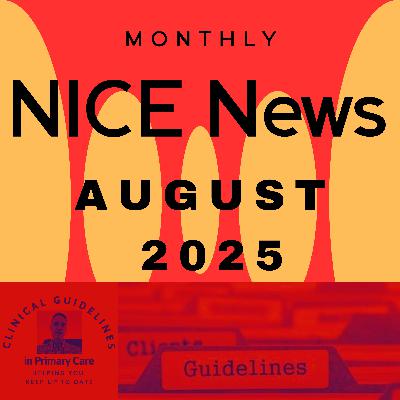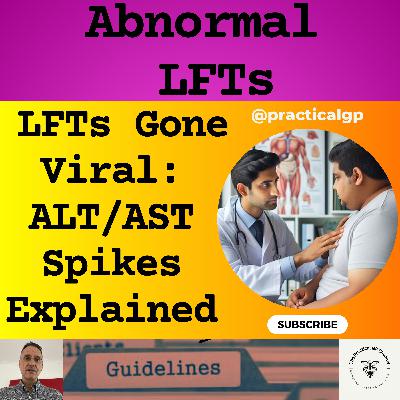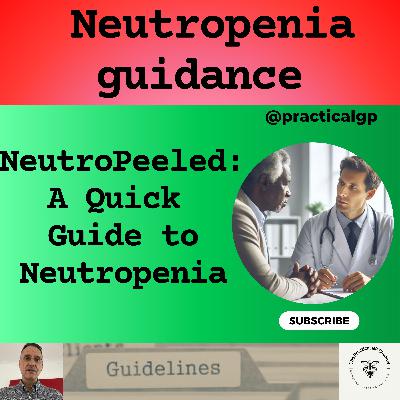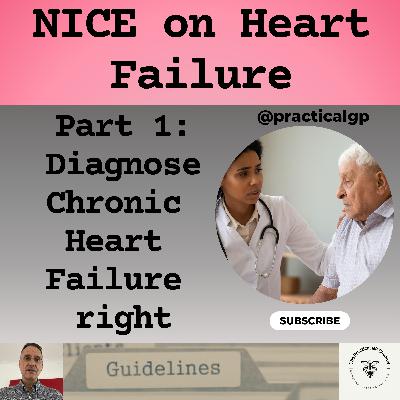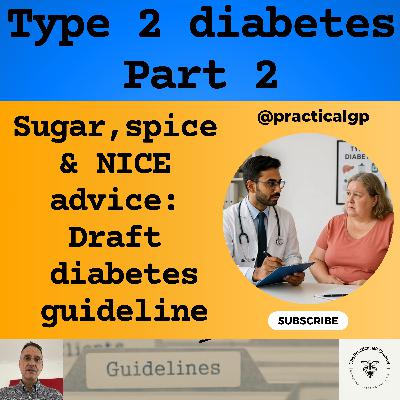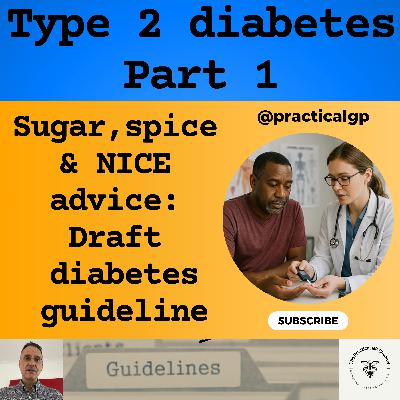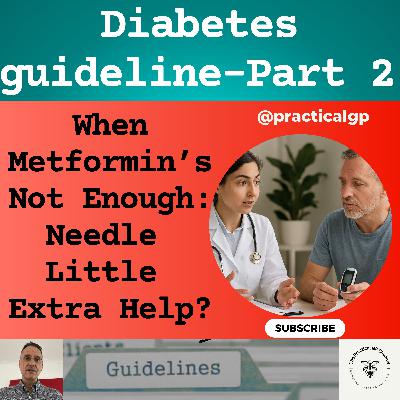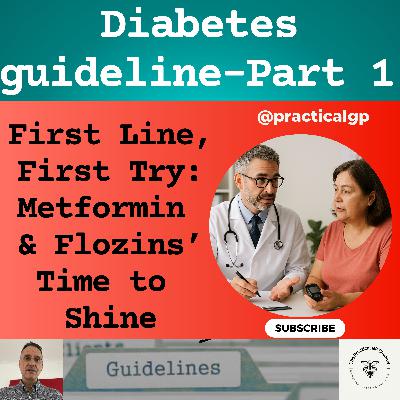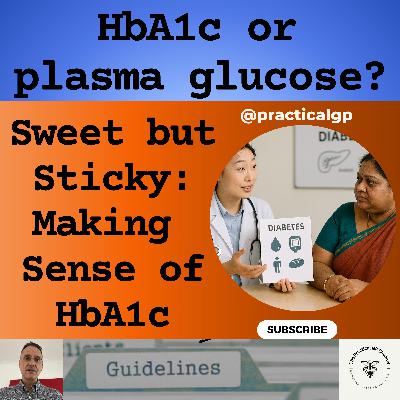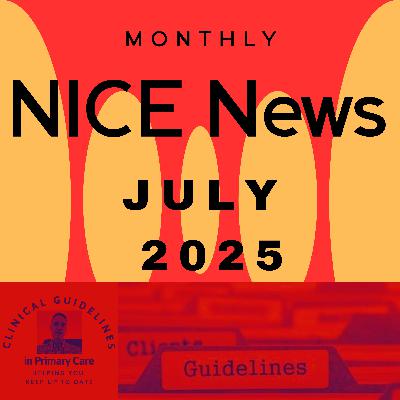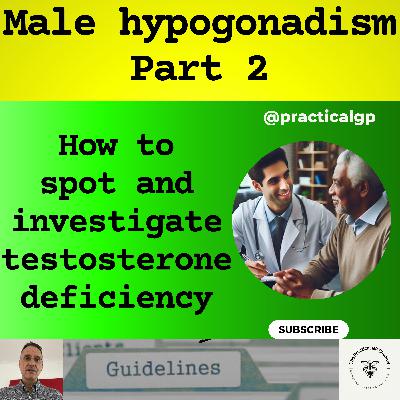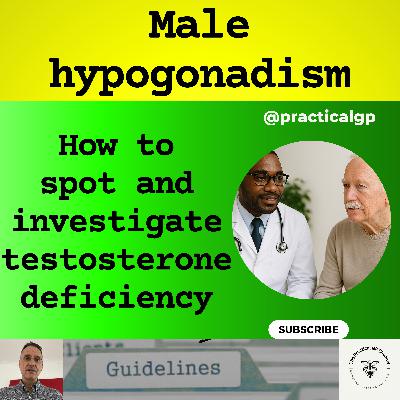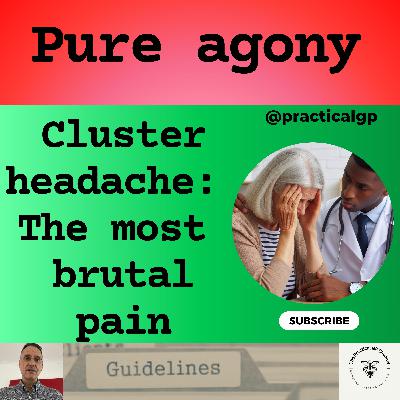Podcast - NICE News - August 2025 including draft NICE guideline on diabetes
Description
The video version of this podcast can be found here:
· https://youtu.be/mHyDaVHtb58
This episode makes reference to guidelines produced by the "National Institute for Health and Care Excellence" in the UK, also referred to as "NICE". The content on this channel reflects my professional interpretation/summary of the guidance and I am in no way affiliated with, employed by or funded/sponsored by NICE.
NICE stands for "National Institute for Health and Care Excellence" and is an independent organization within the UK healthcare system that produces evidence-based guidelines and recommendations to help healthcare professionals deliver the best possible care to patients, particularly within the NHS (National Health Service) by assessing new health technologies and treatments and determining their cost-effectiveness; essentially guiding best practices for patient care across the country.
My name is Fernando Florido and I am a General Practitioner in the United Kingdom. In this episode I go through new and updated recommendations published in August 2025 by the National Institute for Health and Care Excellence (NICE), focusing on those that are relevant to Primary Care only. I also give an overview of the draft NICE guideline on type 2 diabetes open for consultation until October 2025 and due for publication in February 2026.
I am not giving medical advice; this video is intended for health care professionals, it is only my summary and my interpretation of the guidelines and you must use your clinical judgement.
Disclaimer:
The Video Content on this channel is for educational purposes and not intended to be a substitute for professional medical advice, diagnosis, or treatment. Always seek the advice of your physician or other qualified health provider with any questions you may have regarding a medical condition. Never disregard professional medical advice or delay in seeking it because of something you have read or seen on this YouTube channel. The statements made throughout this video are not to be used or relied on to diagnose, treat, cure or prevent health conditions.
In addition, transmission of this Content is not intended to create, and receipt by you does not constitute, a physician-patient relationship with Dr Fernando Florido, his employees, agents, independent contractors, or anyone acting on behalf of Dr Fernando Florido.
Intro / outro music: Track: Halfway Through — Broke In Summer [Audio Library Release]
- Music provided by Audio Library Plus
- Watch: https://youtu.be/aBGk6aJM3IU
- Free Download / Stream: https://alplus.io/halfway-through
There is a podcast version of this and other videos that you can access here:
Primary Care guidelines podcast:
· Redcircle: https://redcircle.com/shows/primary-care-guidelines
· Spotify: https://open.spotify.com/show/5BmqS0Ol16oQ7Kr1WYzupK
· Apple podcasts: https://podcasts.apple.com/gb/podcast/primary-care-guidelines/id1608821148
There is a YouTube version of this and other videos that you can access here:
- The Practical GP YouTube Channel:
https://youtube.com/@practicalgp?si=ecJGF5QCuMLQ6hrk
The Full NICE News bulletin for August 2025 can be found here:
· https://www.nice.org.uk/guidance/published?from=2025-08-01&to=2025-08-31&ndt=Guidance&ndt=Quality+standard
The updated quality standard Overweight and obesity management [QS212] can be found here:
· https://www.nice.org.uk/guidance/qs212
The NICE announcement on Type 2 diabetes management can be found here:
· https://www.nice.org.uk/news/articles/biggest-shake-up-in-type-2-diabetes-care-in-a-decade-announced
The NICE draft guideline on Type 2 diabetes can be found here:
· https://www.nice.org.uk/guidance/gid-ng10336/documents/450
The visual summary of the NICE draft guideline on type 2 diabetes can be found here:
· https://www.nice.org.uk/guidance/GID-NG10336/documents/draft-guideline-2
Transcript
If you are listening to this podcast on YouTube, for a better experience, switch to the video version. The link is in the top right corner of the video and in the episode description.
Hello and welcome! I’m Fernando, a GP in the UK. In today’s episode, we’ll look at the NICE updates published in August 2025, focusing on what is relevant in Primary Care only.
Today there’s just one updated clinical area to cover, overweight and obesity. But I will also mention that the draft NICE guideline on type 2 diabetes has now been made public, so we will discuss that too.
Right, let’s jump into it.
And I know most of you will be keen to hear about the new diabetes guidance, and understandably so. But before we get to that, I would like to spend the first minute and a half on an area that’s often neglected: overweight and obesity. NICE has just released a new quality standard that replaces three separate guidelines, those on children, adults, and general clinical management, and brings them together into a single standard, reflecting new priorities and evidence.
There are eight quality statements on obesity.
In the first two statements, the focus is on better identification. For adults with long-term conditions, BMI should be recorded at least annually, and if BMI is under 35, waist-to-height ratio should also be measured. This represent a change from previous guidance where BMI alone was the main focus. Also, for children over the age of two, BMI should be recorded opportunistically. putting greater emphasis on early recognition.
Statements three, four, and five are all about improving access to services, including people with learning disabilities. Local authorities and commissioners need to maintain an up-to-date list of services to offer patients, which should reduce barriers and ensure equity of access.
Statements six, seven, and eight deal with clinical management. People prescribed weight management medicines should receive holistic care, covering diet, nutrition, and physical activity. Those who stop medicines or finish behavioural interventions should get long term follow up support, which recognises the importance of relapse prevention. And finally, adults discharged after bariatric surgery should be followed up at least annually within a shared-care model. This is also new because the need for ongoing shared care was not explicit before.
And that is it in respect of overweight and obesity. Now let’s move to the real headline, the draft new NICE guideline on type 2 diabetes. This is the one everyone’s been talking about. The draft is open for public consultation until October, and the final guidance is due in February 2026.
Today I’ll just give you a quick overview. But in a future episode, we’ll look at the proposed changes in slightly more detail, so stay tuned. Just remember, for now it’s only a draft, which means it could still change, and we should not be making clinical decisions based on it yet.
First, the biggest shift: Treatment no longer starts with just metformin. Instead, the new draft guideline recommends combination therapy from day one—metformin plus an SGLT-2 inhibitor for almost all adults with type 2 diabetes. This is a major departure from monotherapy and reflects the fact that type 2 diabetes is not only about sugar control. SGLT-2 inhibitors confer cardiac and renal protection, reducing cardiovascular events and slowing kidney disease progression, benefits that metformin alone can’t offer. NICE has been clear that SGLT2 inhibitors remain underutilised in practice. Why? In many cases, clinicians have stuck with the traditional stepwise model of adding medicines only when HbA1c goes up. Others may be concerned about cost, side effects, or uncertainty over who exactly should benefit. The new guideline cuts through that by saying: everyone with type 2 diabetes will benefit, so we need to make SGLT-2 inhibitors part of the standard starting treatment. The message is that we should be thinking beyond blood glucose from the very beginning, and treating cardiovascular and renal risk right from the start.
Second, we move away from risk-based prescribing. In the past, SGLT-2 inhibitors were reserved only for people with heart failure or at high cardiovascular risk, so their use was much more limited. As we have just said, the new draft guideline takes a completely different approach: now, SGLT-2 inhibitors are recommended for everyone with type 2 diabetes, regardless of their car

